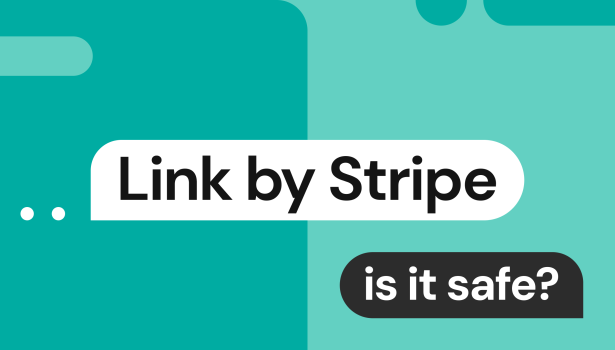Is Link payment safe? What to know about the one-click checkout in 2025

The Link checkout solution is considered highly safe to use. Its creator, Stripe, is a respected fintech company known for having one of the most comprehensive financial infrastructure platforms. Most importantly, Link encrypts user data in transit and at rest and never shares sensitive payment details like credit numbers with merchants.
However, while the platform itself doesn’t pose a risk, problems could arise if you lose your device or fall prey to social engineering.
What is the Link payment method?
The Link payment method is a one-click checkout that autofills your saved payment and shipping details, letting you shop online without constantly re-inputting your card and address. Once you set up a Link account, any future purchase on a site that supports Stripe will show a “Pay with/ Autofill Link” button. Clicking it instantly fills in your details and completes the payment—usually in one click.

If you’re using a new device/ browser or are shopping from a new location, you’ll be asked to verify your identity. This is usually done via a one-time passcode (OTP) sent to your email or phone.
As for payment methods, you can add several cards or bank accounts to your Link account. You’ll need to select a default one, but you can also choose a different method during the transaction.
What’s the deal with one-click checkouts?
If you shop online regularly, you may have noticed that the ultra-accelerated checkout experience is becoming the new standard. This wasn’t really the case a few years ago, when you could only see the one-click “Buy Now” button on Amazon.
That’s because Amazon held the patent for the one-click checkout from 1999 to 2017. When it expired, companies like PayPal, Shopify, and Apple started to take advantage of its simplicity, but it took a couple of years to gather steam.
These days, e-commerce businesses are always looking for a way to reduce “friction” in online shopping, meaning the likelihood that a customer might not complete a transaction. Making checkout quicker and easier is a great way to do this. In fact, Cornell researchers found that one-click checkout buttons increase people’s spending by as much as 28.5% and get them to buy a wider range of items.
While beneficial for merchants, quick checkout is also useful for consumers as it speeds up the process and eliminates the need to type payment details each time. However, since you need to save the details within the platform that provides the one-click checkout service, it naturally raises concerns over how securely the info is stored and who can access it.
Is Link safe for payments?
As far as one-click checkouts go, the Link payment method is considered safe. Its provider, Stripe, is known for having powerful fraud detection capabilities, and the company’s security documentation page demonstrates a commitment to privacy standards. These include:
- PCI Service Provider Level 1. The PCI DSS standards require companies to collect, transmit, and store payment details in a secure manner. Stripe is classified as a Service Provider, and Level 1 applies to service providers processing 300,000+ credit card transactions each year.
- NIST Cybersecurity Framework. This is a set of guidelines that was developed by the U.S. National Institute of Standards and Technology (NIST) to help organizations minimize cybersecurity-related risk.
- SOC certifications. Stripe holds SOC 1 Type II, SOC 2 Type II, and SOC 3 certifications, verifying that its security and privacy controls meet industry-leading standards.

As for specific methods that keep user data safe, Stripe relies on tokenization and encryption:
- Tokenization refers to the practice of replacing a credit card number with a unique, randomly generated string of characters that can’t be reverse-engineered to produce the original number. This means that Link never shares your actual payment details with merchants but shares tokens instead.
- TLS encryption is a cryptographic protocol that’s used to encrypt data moving between client and server. This prevents malicious actors from intercepting and/or tampering with people’s payment details as they’re being sent via a payment gateway.
- AES-256 encryption protects data at rest (when it’s stored on Stripe’s servers). Importantly, your payment details aren’t stored on merchants’ servers, but securely encrypted on Stripe’s infrastructure. This minimizes the risk of exposure in the event of a merchant data breach and prevents numerous businesses from having access to your sensitive data.
For fraud detection and risk monitoring, Stripe employs its own Radar system—machine learning algorithms that detect any suspicious activity while minimizing the likelihood of false positives (which could result in unnecessary chargebacks).
Additionally, the safety of any online transaction starts with one very important step—making sure it’s really you. If you check out from a new device, browser, or location, Stripe initiates identity verification. This is done through a one-time code sent to your email or phone or via biometric authentication like Face ID/ Touch ID (on supported devices).
Common concerns about Link payments
Some users hesitate to trust Link simply because it’s not as well-known as other services like Apple Pay and PayPal. Some merchants even believe that Link was “scaring away” international customers. As it grows in brand recognition, people’s trust in Link will likely increase. After all, it’s a secure payment method and Stripe is a widely recognized brand.

Still, even with the most secure systems, there’s always a way for cybercriminals to take advantage of unsuspecting users. When it comes to Link, the biggest risks are posed by lost devices and social engineering.
Lost or stolen devices
If your device is lost or stolen, and you haven’t protected it with a password or biometrics, then you’re in a tough spot. Whoever gets their hands on it can now see that you’re signed in with Link, and they can make purchases as if they’re you. What’s more, they are likely to bypass any attempts by Stripe to verify your identity—unless you receive an OTP on a different device or use biometric verification.
Social engineering attempts
In recent years, cybercriminals have gotten uncannily good at making their fake websites look like legit services. Stripe has been spoofed too, and the only telltale sign was a slight variation in the domain name that most people wouldn’t have noticed.
This underlines the need to always double-check the URL of the platform you’re surfing. Stripe itself provides info on how to tell if a page is legit. However, you shouldn’t wait until checkout—verify you’re shopping on the correct site first.
User experience and reviews in 2025
Link currently doesn’t have many reviews online, which can be easily explained by the fact that it’s not yet commonly known.
Out of those reviews that have been left, the opinions are mixed. Some appreciate the streamlined checkout process while others feel forced into creating an account. As many are unfamiliar with the service and its security practices, people are skeptical of signing up and sharing their payment details.
Notably, Stripe has been working on brand consistency and clearer communication, which seems to help reduce the confusion.
Tips for safe online payments
Since the biggest risk factors for using Link are losing your device or falling prey to a phishing website, the best ways to stay safe are to:
- Set up passwords and biometrics on your devices. Even if someone gets a hold of your phone, they won’t be able to instantly use it. Not only is this a crucial step to prevent unauthorized access, but it also gives you time to report the problem to relevant services or change the login details to important accounts.
- Only enter data on HTTPS-protected pages. Not all browsers show the https:// in the address bar, but you can usually click on the URL to expand it. In the case of Chrome, click on the padlock-resembling icon to see if it says “Connection is secure.”
- Check to make sure the domain is an official one. Scammers will try to get as close to a legit URL as they possibly can, and they can even create one protected by HTTPS. If you look carefully, though, something will be off—perhaps a dash where there usually is a period or a misspelling.
- Never share a verification code with “Stripe customer service.” These codes are sent out to make sure you’re really you, but Stripe says they’ll never ask you for them. If someone claiming to be a customer service rep asks for the code, they’re probably not actually from Stripe.
- Avoid using public Wi-Fi when entering payment details. Hackers can intercept even HTTPS connections under certain conditions. If you have no other choice, make sure you enable a VPN.
- Periodically review activity and logins in your account. This will help ensure that your account hasn’t been compromised and you’re the only one using it.

Alternatives to Link
The phenomenon of digital wallets and accelerated checkouts has given rise to quite an ecosystem. Here are a few competing one-click solutions:
- PayPal One Touch lets you bypass the usual PayPal login to purchase things using your PayPal account without entering a password each time. The main difference in how they operate is that PayPal One Touch draws from your PayPal account to process payments while Link stores your actual payment details for direct use across any merchant using Stripe.
- Apple Pay is Apple’s digital wallet and contactless payment system that lets you pay online or in stores using saved cards linked to your Apple ID. Transactions are authorized through Face ID, Touch ID, or a device passcode, and Apple replaces your actual card number with a unique device-specific token.
- Google Pay is similar to Apple Pay, but for Android devices. It’s tied to Google’s ecosystem and best for users who stay within Google services or Android devices, while Link offers cross-platform usability across thousands of independent online merchants.
Conclusion: should you use Link by Stripe?
Everyone’s level of comfort with one-click payments is different, but what’s certain is that Link is a safe and convenient choice for most users in 2025.
As long as you’re protecting your device with passwords and biometrics, and you’re aware of the ways cybercriminals try to spoof websites for phishing purposes, you’ll most likely be able to use the service without incident.
FAQs
What is Link payment?
Link payment is a one-click checkout solution created by Stripe, an Irish-American financial services company that was founded in 2010. It autofills your payment and shipping details on Stripe-supported websites so that you don’t have to enter them manually.
Is Link payment legit?
Yes, Link payment is legit. It’s provided by Stripe, a legitimate company that powers online transactions for millions of businesses worldwide, offers strong security, and complies with industry regulations.
Is Link payment safe?
Yes, Link payment is safe. Its parent company, Stripe, is one of the most trusted payment processing services thanks to its industry-leading fraud detection capabilities and robust data protection practices. Just be sure to protect your devices with passwords or biometrics and always double-check the URL you’re shopping on.





Mark comes from a strong background in the identity theft protection and consumer credit world, having spent 4 years at Experian, including working on FreeCreditReport and ProtectMyID. He is frequently featured on various media outlets, including MarketWatch, Yahoo News, WTVC, CBS News, and others.